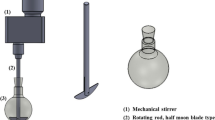Abstract
The hollowness of crosslinked hollow phenolic fibers was regulated successfully from 9 % to 80 % by adjusting the curing temperature of the partially crosslinked fibers. The partially crosslinked fibers was studied in detail by mass gained, tensile strength, solvent dissolution, SEM, IR, and TG analysis, and the prepared hollow phenolic fibers with different degrees of hollowness were characterized with SEM, tensile strength, TG-DSC and TG-MS. The results show that the factor determining the hollowness is the crosslinked extent of the partially crosslinked fibers and the hollow fibers with different degrees of hollowness have similar crosslinkage, mechanical properties and thermal stability.
Similar content being viewed by others
References
J. Economy and R. A. Clark, U.S. Patent, 3,650,102 (1972).
D. Petrulis, J. Appl. Polym. Sci., 92, 2017 (2004).
T. Nakajima, K. Kajiwara, and J. E. McIntyre, “Advanced Fiber Spinning Technology”, Chap.5, Woodhead: Cambridge, Appendix, 1994.
M. Galop, A. Lamure, and C. Lacabanne, J. Appl. Polym. Sci., 78, 8 (2000).
S. P. Rwei, J. Appl. Polym. Sci., 82, 2896 (2001).
S. Kuwayama, M. Kasajima, and J. Hanaoka, JP2007056419-A (2007).
K. Matsuda, Y. Tanaka, and K. Kikuchi, JP2006045720-A (2006).
D. Q. Zhang, J. L. Shi, Q. G. Guo, Y. Song, L. Liu, and G. T. Zhai, J. Appl. Polym. Sci., 104, 2108 (2007).
S. L. Hayes, “Encyclopedia of Chemical Technology”, Wiley, New York, 1981.
P. J. Bruyn, L. M. Foo, A. S. C. Lim, M. G. Looney, and D. H. Solomon, Tetrahedron, 53, 13915 (1997).
K. Ohtomo and T. Nakamori, U.S. Patent, 3,996,327 (1976).
C. L. Liu, Q. G. Guo, J. L. Shi, and L. Liu, Mater. Chem. Phys., 90, 315 (2005).
C. L. Liu, Y. G. Ying, H. L. Feng, and W. S. Dong, Polym. Degrad. Stab., 93, 507 (2008).
W. W. David, W. Jason, S. B. Claudia, and J. K. William, Polymer, 47, 1207 (2006).
K. Roczniak, T. Biernacka, and M. Skarzynski, J. Appl. Polym. Sci., 28, 39 (1983).
A. F. Ismail and L. I. B. David, J. Membr. Sci., 193, 1 (2001).
C. Y. Wang, M. W. Li, Y. L Wu, and C. T. Guo, Carbon, 136, 1749 (1998).
K. A. Trick and T. E. Saliba, Carbon, 33, 1509 (1995).
J. I. Ozaki, W. Ohizumi, and A. Oya, Carbon, 38, 1515 (2000).
Author information
Authors and Affiliations
Corresponding author
Rights and permissions
About this article
Cite this article
Zhang, D., Shi, J., Guo, Q. et al. Studies on hollownesss regulation and properties of crosslinked hollow phenolic fibers. Fibers Polym 13, 495–500 (2012). https://doi.org/10.1007/s12221-012-0495-z
Received:
Revised:
Accepted:
Published:
Issue Date:
DOI: https://doi.org/10.1007/s12221-012-0495-z




